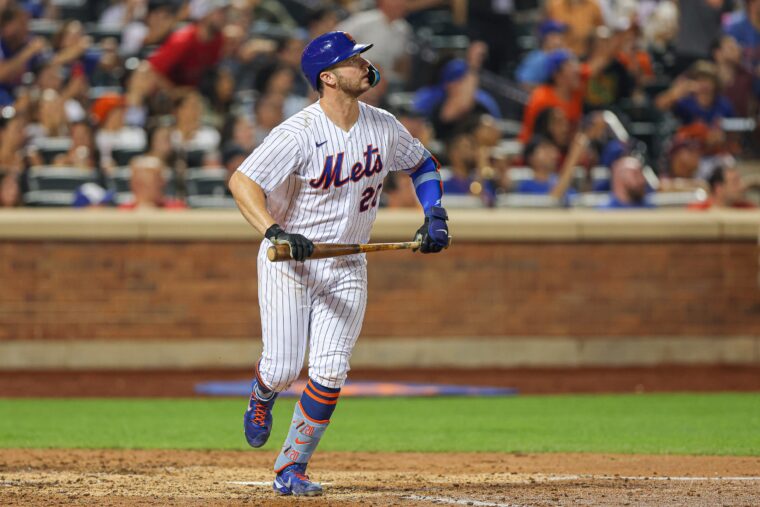
Vincent Carchietta-USA TODAY Sports
It wouldn’t be much of a novelty to state that Pete Alonso is the Mets’ biggest power threat—not heading into 2023, not in 2022, and not in any season since he joined the major league club in 2019.
That being the case, it is more puzzling to understand why the other major league teams took three years to catch up to that fact—or, at least, in one area they did.
From 2019 through 2021, Alonso was intentionally walked a combined 16 times, or about once per 98 plate appearances.
In 2022, Alonso matched his prior three-year total, piling up 16 intentional free passes, or about one every 43 plate appearances. Those 16 IBBs were good for third in the majors, behind only José Ramírez (20) and Aaron Judge (19).
What changed in 2022? Why was Alonso intentionally walked so often compared to previous years? Did it even work?
2022 Change
The most straightforward explanation for why Alonso was intentionally walked more often in 2022 than in his prior three seasons was that the Mets’ offense was far better. This led to increased RBI situations, including scenarios where Alonso came up with first base open.
Ironically, though, the Mets’ fifth-ranked 2022 offense by runs scored was actually the second-worst in runs scored per game from Alonso’s four-year career, ahead of only the 2021 outfit. From 2019 to 2022, the Mets have averaged 4.88, 4.77, 3.93, and 4.73 runs per game, respectively. It is a mark of how much offense was down across baseball that last year’s 4.73 mark tied for fifth, whereas 2019’s 4.88 runs per game ranked 13th, and 2020’s 4.77 ranked 12th (albeit in a small sample size of 60 games; the Mets ranked 27th in runs scored in 2021).
Nevertheless, with runs at more of a premium across the league, it makes sense that a team would want to intentionally walk the greatest power and RBI threat on the fifth-ranked offense in baseball—at least, if you believe that intentional walks are a sound strategy to begin with (more on that later).
Following Hitter
Alonso predominantly batted fourth for the Mets in 2022. When he was intentionally walked, the hitter behind him was one of Darin Ruf, Eduardo Escobar, Daniel Vogelbach, J.D. Davis, Luis Guillorme, or Mark Vientos. None of those batters inspired fear in opponents anywhere near the level of Alonso, and only Vogelbach really inspired any fear at all.
In fact, five of Alonso’s intentional walks came with Darin Ruf hitting after him. Several of them came when the opponent had in a left-handed pitcher and was going for the platoon advantage against the left-handed Vogelbach. The Mets would automatically pinch-hit Ruf for Vogelbach in those situations.
Notice that Alonso was not intentionally walked when Jeff McNeil was batting fifth.
Overall, in the at-bat following Alonso’s intentional walks, the Mets were 4-for-15 with 9 RBI, 5 strikeouts, and one sacrifice fly. They had one grand slam and one walk-off hit in those at-bats. However, there were also two instances when Alonso was intentionally walked with fewer than two outs and scored on a hit two or more batters after his walk.
Did the teams gain from intentionally walking Alonso? Perhaps, as they got the out they needed to end the inning in nine instances, including one forceout at second. However, the four hits, sacrifice fly, and RBI in subsequent at-bats were damaging enough to make those teams reconsider the strategy in hindsight, even with the lesser hitters behind Alonso.
For the Mets, though, they might want to think long and hard about who their hitter after Alonso is. In 2022, Vogelbach put up a .236/.387/.446/.832 from the fifth spot in 137 PA, while Ruf went .159/.220/.205/.425 in 50 PA. Following an Alonso intentional walk, Vogelbach was 1-for-3 with a grand slam, a strikeout, and a fly-out DP (Marte was thrown out at the plate trying to score on a flyout), while Ruf was 1-for-5 with two strikeouts and a two-run single.
To Walk or Not To Walk
Current Mets manager Buck Showalter issued perhaps the most infamous intentional walk in MLB history when he chose to walk Barry Bonds with the bases loaded. In May 1998, Showalter’s Arizona Diamondbacks were leading Bonds’ San Francisco Giants 8-6 with two outs in the ninth inning.
Showalter, who had no bullpen left, took the risk to walk Bonds, the most feared hitter in the game, and take his chances with Brett Moyne. It paid off when Moyne lined out to right to end the game.
An average baseball fan would likely justify Showalter’s move in that situation. FanGraphs Baseball and other analytical outlets, however, have calculated that walking in a run with the bases loaded never makes sense—not even when that hitter is peak Barry Bonds.
Overall, the intentional walk should and have been going the way of the bunt and the stolen base (pre-2023, anyway): used less and less often. Just as giving up extra outs on the offensive side is foolhardy, allowing extra base runners is not a sound strategy.
The Mets happily took the extra base runners when Alonso was intentionally walked. Did they capitalize as much as they could have? No. But nine RBI in 16 at-bats is a pretty hefty ratio, and, when you add in the two other subsequent hits that led to Alonso’s scoring, they received 11 extra runs as a result of the intentional walk strategy. (Maybe they actually want the other team to keep doing it.)
Showalter talks a lot about blending an old-school for the game feel with new-age analytics. He might want to lean more on the latter when it comes to intentional walks. From an offensive standpoint, though, the number one idea must be not to take the bat out of his best hitters’ hands.














